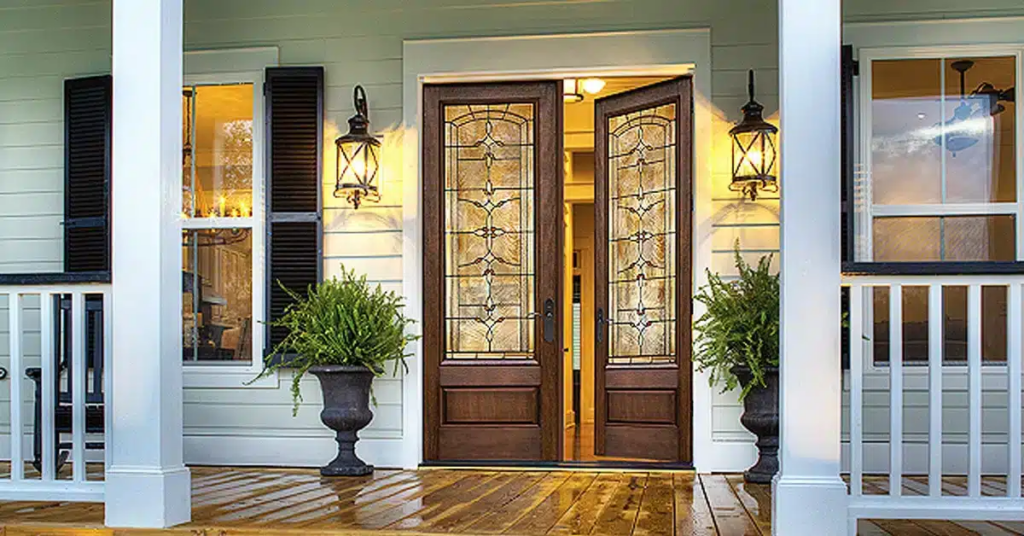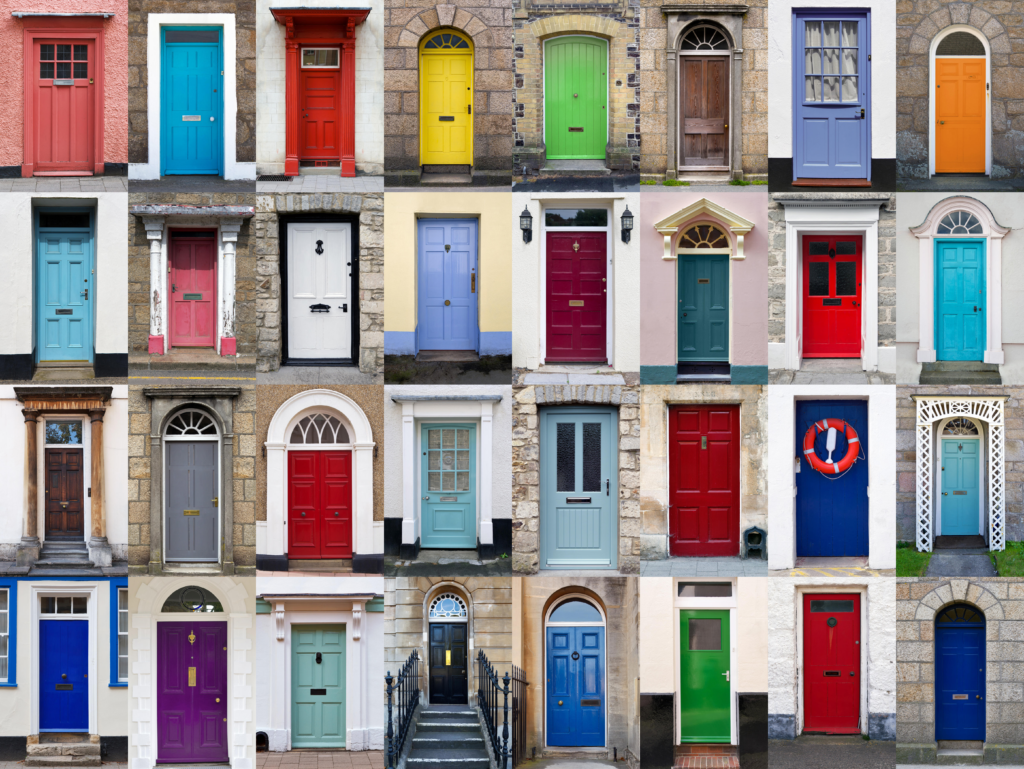Choosing the perfect front door is a crucial decision for any homeowner. It not only enhances the aesthetic appeal of your home but also provides security, insulation, and energy efficiency. This guide will walk you through key considerations, materials, styles, and finishes to help you select the ideal front door for your property.
Understanding Your Needs
Before diving into styles and materials, it’s essential to assess your specific needs. Consider factors such as security, insulation, and aesthetics. Think about your home’s architectural style and the overall look you wish to achieve. If security is a primary concern, look for doors with strong locking mechanisms and durable materials.

Additionally, consider your climate. In colder regions, a door that provides excellent insulation can help reduce energy costs. If you live in a humid area, materials resistant to warping and mold would be beneficial. Understanding these needs will help narrow down your options significantly.
Exploring Different Materials
Front doors come in various materials, each offering unique benefits and drawbacks. Common materials include wood, fiberglass, steel, and aluminum.
Wood doors are classic and elegant, providing a warm and inviting appearance. However, they require regular maintenance to prevent warping and weather damage. Fiberglass doors are a popular alternative, as they mimic the look of wood but are more resistant to the elements. They are energy-efficient and require little maintenance, making them a practical choice.

Steel doors offer exceptional security and durability. They are usually insulated, making them energy-efficient as well. However, they can be prone to rust if not properly coated. Aluminum doors are lightweight and resistant to corrosion, but they may not provide the same level of insulation as other materials.
Choosing the Right Style
The style of your front door should complement your home’s architecture. Common styles include traditional, modern, rustic, and craftsman. Traditional doors often feature raised panels and decorative molding, while modern doors tend to have clean lines and minimalistic designs.
Rustic doors typically use natural wood with a distressed finish, ideal for homes with a country or farmhouse aesthetic. Craftsman-style doors feature intricate details and often include glass elements. Consider the existing elements of your home, such as windows and trim, to ensure a cohesive look.
Security Features to Consider
A front door is often the first line of defense against intruders. When selecting a door, prioritize security features. Look for solid construction, reinforced frames, and high-quality locks. Many steel doors come with multi-point locking systems that secure the door at multiple points, making it harder to breach.
Additionally, consider adding a peephole or a security camera near the door. Smart locks that can be controlled via smartphone apps offer convenience and enhanced security features. Installing a solid security door frame can also provide added protection against forced entry.
Energy Efficiency Matters
Energy efficiency is a crucial aspect of any front door. An energy-efficient door helps maintain your home’s temperature, reducing heating and cooling costs. Look for doors with high energy ratings, which indicate superior insulation properties.
Consider doors with a thermal break—a layer of insulating material that separates the interior from the exterior. This feature helps prevent heat transfer, adding to the door’s energy efficiency. Additionally, ensure the door has proper weather stripping and seals to minimize drafts.
Door Size and Dimensions
Selecting the right size for your front door is essential for both aesthetics and functionality. Standard front doors typically measure 36 inches wide and 80 inches tall, but you should measure your existing door frame to ensure the new door fits correctly.
If you want to create a grand entrance, consider a double door setup or a larger door. Be mindful that larger doors may require more robust framing and support, potentially increasing installation costs. Always check local building codes for any size restrictions.
Color and Finish Options
The color and finish of your front door can significantly impact your home’s curb appeal. Neutral colors, such as white or beige, provide a timeless look, while bold colors like red or navy can make a statement. Consider colors that complement your home’s exterior, including siding, brick, or stone.

When it comes to finishes, you can choose between paint, stain, or natural finishes. Painted doors offer versatility, allowing you to change the color easily down the line. Stained wood doors highlight the natural grain, adding warmth and character. If you opt for a metal door, consider finishes like powder coating for added durability and an attractive appearance.
Glass Elements and Additions
Adding glass elements to your front door can enhance natural light and create an inviting atmosphere. You can choose from various designs, such as sidelights, transoms, or decorative glass panels. Frosted or textured glass provides privacy while still allowing light to filter through.

When incorporating glass, consider its energy efficiency and security. Double or triple-pane glass offers better insulation, while tempered or laminated glass provides added security against breakage. Ensure any glass elements are properly sealed and fitted to prevent air leaks.
Budget Considerations
Setting a budget is crucial before shopping for a front door. The price can vary significantly based on materials, styles, and additional features. On average, homeowners can expect to spend anywhere from $500 to $2,500 for a quality front door, with installation costs adding an additional expense.
While it can be tempting to choose the cheapest option, consider the long-term benefits of investing in a durable, energy-efficient door. Higher-quality materials may have a higher upfront cost but can save you money on energy bills and maintenance in the long run.
Professional Installation vs. DIY
Deciding whether to install the door yourself or hire a professional depends on your skills and experience. While DIY installation can save you money, it requires a good understanding of carpentry and precise measurements. If you choose to go the DIY route, ensure you have the right tools and follow manufacturer instructions closely.
On the other hand, hiring a professional can ensure a proper fit and finish, reducing the risk of issues arising later. Professionals can also handle any adjustments needed for framing or weatherproofing. If you’re uncertain about your abilities, it may be worth the investment to hire a skilled tradesperson.
Maintenance Requirements
Different types of doors have varying maintenance needs. Wooden doors require regular staining or painting to protect against moisture and UV damage. Fiberglass doors are relatively low maintenance, but occasional cleaning is necessary to keep them looking fresh.
Steel doors may need touch-ups to prevent rust, especially in coastal areas. Aluminum doors are generally easy to maintain but should be cleaned periodically to avoid oxidation. Understanding the maintenance requirements of your chosen door will help you keep it in good condition for years to come.
Enhancing Curb Appeal
Your front door plays a significant role in your home’s curb appeal. Enhancing it can increase the overall value of your property. Consider adding decorative hardware, such as stylish handles and hinges, to elevate the door’s look. A new doorbell or house number can also add charm.
Landscaping around the entrance can draw attention to your front door. Consider adding potted plants, outdoor lighting, or a welcoming mat. These details create an inviting entrance and can complement the style of your new front door.
Final Thoughts on Choosing the Perfect Front Door
Selecting the perfect front door is an important decision that impacts your home’s aesthetics, security, and energy efficiency. By considering your needs, exploring materials and styles, and accounting for budget and maintenance, you can find a door that enhances your home’s appeal and functionality. Take your time during this process, as a well-chosen front door can offer lasting benefits for years to come.
FAQs
1. How long does a front door typically last?
A well-maintained front door can last anywhere from 20 to 30 years, depending on the material and environmental factors.
2. Can I paint my fiberglass door?
Yes, fiberglass doors can be painted. Ensure you use exterior-grade paint for the best results and durability.
3. What is the best type of door for high-security situations?
Steel doors are often recommended for high-security situations due to their strength and durability.
4. How often should I replace weather stripping on my door?
It’s advisable to check weather stripping annually and replace it if you notice any wear or air leaks.
5. Are there eco-friendly options for front doors?
Yes, many manufacturers offer eco-friendly doors made from sustainable materials or those with energy-efficient designs to reduce your carbon footprint.